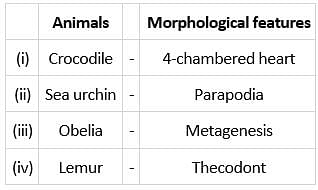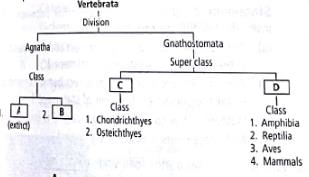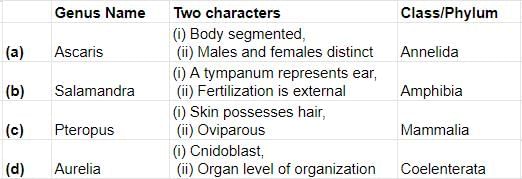Test: Classification of Chordates - NEET MCQ
30 Questions MCQ Test - Test: Classification of Chordates
Which one of the following is a matching pair of a body feature and the animal possessing it?
Given below are two statements: one is labeled as Assertion (A) and the other is labeled as Reason (R).
Assertion (A):
All vertebrates are chordates but all chordates are not vertebrates.
Reason (R):
Notochord is replaced by a vertebral column in the adult vertebrates.
In the light of the above statements, choose the most appropriate answer from the options given below :
| 1 Crore+ students have signed up on EduRev. Have you? Download the App |
Which one of the following is a matching pair of an animal and a certein phenomenon it exhibits?
Which one of the folowing phyla is correctly matched with its two general characteristics?
Which of the following pairs are correctly matched?

Which of the following is an exclusive character of class mammalia?
A common characteristic of all vertebrates without exception is
Read the given statements and select the correct option.
Statement 1: Cephalochordata bears notochord all along the body throughout life.
Statement 2: Urochordate bears vertebral column only in tail region throughout the life.
Which one of the following statements about all the four of Spongila, leech, dolphin and penguin is correct?
Identify the aquatic mammal(s) from the following.
(i) Bataenoptera
(ii) Equus
(iii) Delphinus
(iv) Pteropus
(v) Felis
Which one of the following groups of animals is correctly matched with its characteristic feature without any exception?
Which one of the following statements is incorrect about the occurrence of notochord?
In some chordates, the notochord is modified as the vertebral column. Such animals are called vertebrates. Which one of the following statements makes sense?
Which one of the following pairs of animals are similar to each other for the feature stated against them?
Which of the following group is formed of only the hermaphrodite organisms?
Which of the following groups of animals are uricotelic?
Examine the figures given below and identify the option which represents correct grouping of the labelled figures A, B, C and D.


Which of the following are correct?
(i) Sponges: Cellular level of organization
(ii) Cnidaria : Tissue level of organization
(iii) Platyhelminthes: Organ level of organization
(iv) Annelids, Arthropods, Molluscs, Echinoderms and Chordates: Organ system level of organization.
What is common between parrot, platypus and kangaroo?
Select the correct option that represents examples of the following types of animals.
(i) Cold blooded animal
(ii) Warm blooded animal
(iii) Animal possessing dry and cornified skin
(iv) Dioecious animal

Match Column-I with Column-II and select the correct option from the codes given below.
Column-I
(A) Amphibia
(B) Mammals
(C) Chondrichthyes
(D) Osteichthyes
(E) Cyclostomata
(F) Aves
Column-II
(i) Air bladder
(ii) Cartilaginous notochord
(iii) Mammary glands
(iv) Pneumatic bones
(v) Dual habitat
(vi) Sucking and circular mouth without jaws
You have discovered an animal having characters like, triploblastic, bilateral symmetry, coelomate, chitinous exoskeleton, head, thorax and abdomen as body parts, and jointed appendages.
You should place the animal under
Go through the following flowchart for division of subphylum vertebrata. Fill the gaps A, B, C and D and select the correct option.


Identify the animal (A) and name the phylum to which its belongs (B).

Which of the following statements are incorrect regarding class Amphibia?
(i) Has body divisible into head and trunk. Tail is present in some amphibians.
(ii) Show respiration by gills, lungs and through skin.
(iii) Has scales in all its members.
(iv) Can lead dual life (aquatic and terrestrial).
(v) Has eyelids.
In which one of the following, the genus name, its two characters and its class/phylum are correctly matched?

Which of the following is/are not the characteristics of the class Osteichthyes?
(i) Body is streamlined and mouth is terminal.
(ii) Gills are covered by operculum.
(iii) Skin covered with cycloid and placoid scales.
(iv) Many of them are viviparous.


















